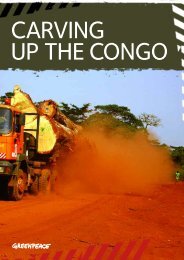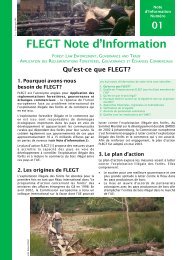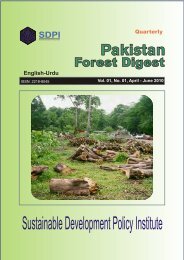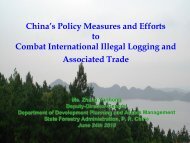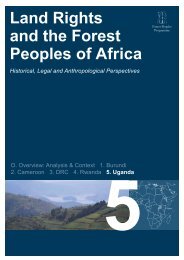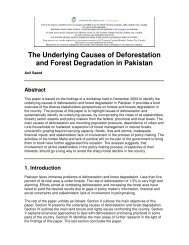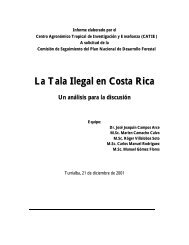CHAINSAW MILLING IN GHANA: CONTExT, DRIVERS ... - Fornis.net
CHAINSAW MILLING IN GHANA: CONTExT, DRIVERS ... - Fornis.net
CHAINSAW MILLING IN GHANA: CONTExT, DRIVERS ... - Fornis.net
- No tags were found...
Create successful ePaper yourself
Turn your PDF publications into a flip-book with our unique Google optimized e-Paper software.
Chapter 5. Social, economic and environmental impactsIn estimating the potential loss of revenue to the state, two main parameters wereused:• the average recommended stumpage rate, which is GHC 10.5/m 3 (Birikorangand Rhein 2005); and• the annual volume of trees harvested by chainsaw operators, which is estimatedto be 2.5 million m 3 (Table 13).The analysis shows that the government may be losing more than GHC 25 millionper year in stumpage that could have been collected from chainsaw operators. This isfar more than the actual stumpage being collected by the FC 17 from licensed loggers.In the first half of 2007, only GHC 4.2 million was collected as stumpage by the FC. 18Assuming that the annual stumpage collected is twice this amount (GHC 8.4million), the potential loss would be about 300% of actual stumpage revenue. If halfof the potential stumpage from chainsaw operators could be captured under a regularisedregime and harvesting at current levels, this would amount to approximatelyGHC 12.6 million. This is almost equal to the total stumpage charged to contractorsand about twice the actual stumpage revenue that the FC expected to collect anddisburse in 2008. 19Since chainsaw operators currently pay about 38% of the potential stumpagerevenue to farmers/land-owners as fees for trees (and assuming that the FC would bewilling to pay this amount to farmers/land-owners to compensate them for protectingthese trees) the FC could still retain revenue of about GHC 14 million annuallyfrom the potential stumpage of GHC 26.1 million. This is the figure that is really lostto the FC, since chainsaw millers do not pay stumpage because of the absence ofa legal regime for their operations. This estimate does not include the revenue lossfrom land rents, export levies and other taxes related to industrial operations in thetimber sector.Many people support the idea of paying direct economic benefits to farmers as a wayof building state-community partnerships to deal with illegal logging (Marfo 2004;Marfo, Acheampong and Osae 2006). The argument that the 50% (until recently,40%) of timber revenue collected by the FC from off-reserve areas could be distributedto communities/farmers to compensate them for tending and managing naturallyoccurring trees on their lands/farms seems to be supported by the aforementionedobservations. In fact, farmers earn almost this much in direct payments from chainsawoperators.Marfo, Adam and Obiri (2009) estimated total informal payments in 2007 to be GHC1.7 million, based on payments made by a sample of operators and the estimatednumber of chainsaw operators. This is about 55% higher than the 1999 estimationby Birikorang et al. (2001) of GHC 1.1 million. However, narrative accounts ofoperators support a volume-based approach to estimate informal payments. This isbecause the charges made by recipients of these payments are often based on thequantity of lumber being produced and transported. Thus, population-basedestimates could be substantially underestimating informal payments. It is estimated43




